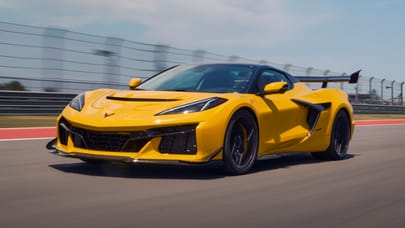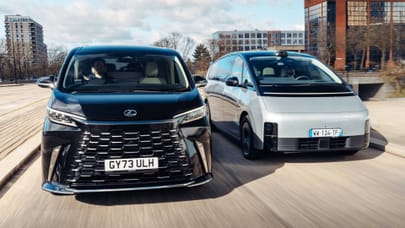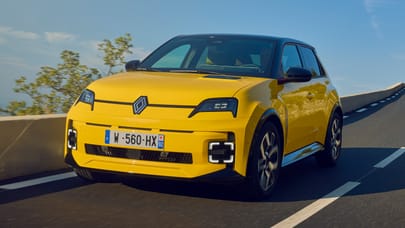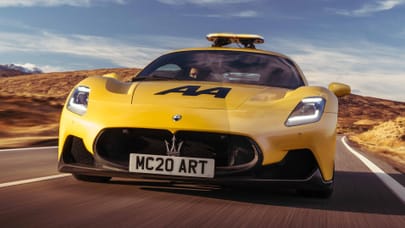
Volkswagen California: can it do big miles and random semi-extreme camping?
The Arctic. Minus 20°C. Sounds just about perfect for a Top Gear mini-break in a VW Cali'
A cosmic sea lapping against the shores of our atmosphere, that's the way I think of the aurora borealis. I’ve seen the northern lights in full force before, and it really was a gently gobsmacking moment, waves of greens, yellows and reds blushed across the night sky in watercolour washes, wonder reflected in the backs of eyes. At the spring equinox, some 200 miles north of the Arctic Circle and 12 miles from the Russian border with Finland, camped on an ice lake as far from artificial light pollution as I could reasonably get, I thought I had a chance of a repeat performance. Nope. There’s nothing. Nada. Zilch.
It’s -20ºC, I can’t be bothered to put on enough clothes to go outside and it wouldn’t matter if I did – the sky has been painted institutional grey by clouds intent on Valium views. Still, we hoped for the lights, but what we’re actually here for is an untypically deep dive into whether or not the new Volkswagen California camper is actually any good at big miles and random semi-extreme camping, and how aggressively this Ocean spec can defend a price of more than £80k. So far, so unhypothermic, I’m already counting it as a win.
We began, some 700 miles ago, in Helsinki. A longer than anticipated supply run in an absolutely enormous Finnish supermarket for vital survival foods (mainly Jaffa Jims and coffee, the Jims being indigenous Jaffa Cakes, you have to be adventurous in foreign climes), before barging our way to Kempele, just south of the larger town of Oulu for a quick ’n’ dirty overnight.
Photography: John Wycherley
Initial impressions of the Multivan-based California are good. It’s got the kind of acceleration that’s best described as a gentle push from kind hands, 62mph from rest reached in something around 10 seconds, the point something lost in the mildly gruff combination of 2.0-litre four cylinder petrol engine and seven cog DSG gearbox. The changes are fast, the engine powerful enough at just over 200bhp/236lb ft, but this is a big thing – 2.4 tonnes of weatherproof textile and metal – and we’ve jammed a bit more than the 450ish kg of official payload into its gut.
But it’ll settle right back at motorway speeds, especially the Finnish max of 62mph, steering, suspension and brakes all the gentle side of good enough. It’s a lightly cumbersome car, but a very nippy house, and small and swivelly enough to negotiate a tight underground car park or urban traffic without needing HGV training. Big miles are easily – if relatively sedately – covered without issue.
It is not, however, the easiest thing to convert to overnight accommodation when you’re very tired and everyone else in the crew has a convenient hotel room. And you’re staying in the back end of what amounts to a truck stop. It also doesn’t have a toilet. Or a shower. Which will become relevant later. But we’re going for rest here, not necessarily relaxation, so I just fold the rear pair of seats (the Cali is a four seater) – after reversing the headrests – flap out the mattress pad, swivel the dual captain’s chairs, attach/insert/pull down the blackout window blinds and set the auxiliary petrol heater to max.
And then wait a bit for it to warm up... most of the above requires open doors and fiddling, and it’s still into the double minus figures, and snowing. I don’t pop the popup roof, it’s not insulated enough and I would likely freeze in some sort of really unfortunate rictus, so low roof it is. And it’s... nice. Warm, at least, but with a slight lack of storage and minimal headroom. Yes, you’ve got cupboards, but not many, and there’s no space for a portable toilet, so I resort to, um, bottles. But it’s actually a decent bed for one, although tight for two. And you lose the upper sleeping deck when it’s too cold.
Top Gear
Newsletter
Thank you for subscribing to our newsletter. Look out for your regular round-up of news, reviews and offers in your inbox.
Get all the latest news, reviews and exclusives, direct to your inbox.
Next morning, and everything is as you might expect. Some late night shenanigans with drunk people around the van led to disturbed sleep, but generally it was pretty cosy, if decidedly practical. But there are miles to do, so we head off again into a pretty snowstorm that proved to be hard work to drive in. The California was imperious mind, even with just front wheel drive rather than the optional AWD. Yes, it’s fitted with winter tyres, but it managed traction on fresh powder with very little fuss. Braking distances are doubled and accompanied by the fizz and chatter of excited ABS, but it’ll go and stop with a remarkable lack of interest. Which is what you want – flamboyant dynamic behaviour in ‘I need to stop before crashing’ braking phases is generally unwelcome.
There was, however, more to come. As in, more and more miles – some 350-ish needed to be added before we reached the top of our journey, which slightly stalled when the Finnish police blocked the petrol pump I was using and detained us. Now, this might seem blindingly obvious in hindsight, but we really didn’t think about our proximity to the Russian border and our use of drones. Fully legal and insured, we were filming the California on a particular stretch of road and were reported by some passersby.
What ensued was likely the slowest police chase of all time, seeing as we had subsequently moved on and the police had to chase us for 25 miles, before catching up to us at the petrol station. And when a Finnish policeperson gets a little bit in your face, you pay attention – Finns are remarkably good at the stoic seriousness that speaks of fines, deportations and cavity searches.
It took a little persuasion, but eventually we convinced the police that we weren’t the world’s worst prepared insurgents, but merely hapless writers, and we were let go. And the cops were really nice after all, although the last words of one made me think quite a lot. “Given the state of the world right now, and our neighbours, we had to check.” Which makes you think all sorts of things about borders, proximity and caution. And making sure you don’t lob drones into the sky without thinking properly about where you are.
Crisis averted, we kept on keeping on, safe and secure in our California even when the landscape morphed from cheerily Christmassy – the Arctic Circle line in Napapiiri is Santa central and tooth rottingly twee – to something more barren and properly arctic. There is still a lot of silver birch and Finnish pine, but they take a lot longer to grow up here, lightly crippled by the wind and cold. But eventually, we made it to our final testing destination to put the VW properly through its paces.
A literal testing destination – UTAC Ivalo, the most northerly automotive test facility in the world. Now, there are several UTACs globally – the big test site in the UK is in Millbrook in Bedfordshire – but there are also facilities in France, Morocco, Michigan and California, Trebur in Germany and offices in China.
But UTAC Finland is special, because it’s the ice lab. Test facilities for cars do all sorts of stuff, but Ivalo contains some really weird setups with which you can assess electronics, tyres, systems and all things car. Yes, there are the usual open forest tracks, ice tracks, snow tracks and giant circular tracks – all of which we sampled in the name of ‘testing’ – but they’re not even the good bits. The 1,000 metre long, 100 metre wide landing strip – graded like a ski slope on the flat – is fun, even in a VW camper, but the oddities are actually inside.
Yep, to maintain the ability to cold weather test even in the Finnish summer, UTAC Ivalo has a series of indoor test labs that are on a scale you wouldn’t believe. Giant car chillers that mean you can do cold starts from -50°C every day. A snow drag strip that’s six lanes wide and 410 metres long that loops into an indoor snow handling circuit. A similar straight test track that’s made of nothing but clear, slick ice – exclusively to test studded tyres. All temperature controlled, freezing and packed with snow harvested from the site during winter.
It’s deeply weird and utterly brilliant, little cathedrals of testing, like dwarven underground halls. And the camper traversed them all, skidding about in a very uncamperlike manner, safe, secure, and above all warm. And that’s what it’s about here, taking the vagaries of nature and minimising the variables, making the testing repeatable, robotic and measurable. If you ever wondered how brutally and incessantly new stuff was tested and developed, UTAC Ivalo has all the equipment for automotive torture.
Which is kind of where we came in – the ice lake I then camped on is in one of Ivalo’s far corners, away from prying eyes and bright lights. I make a proper camp this time, more familiar with the setup. The awning unfurled, the camping tables and chairs from the tailgate unslotted. The single ring burner produced hot drinks, and the poptop popped. It’s designed to have a tent threaded through the rail on the other side, and once it’s all out and open, you can see how summers would be more spaciously passed in this thing.
That’s when I got it. A camper is really about freedom. The ability to just get in and go
But this is not summer, so when it’s time to sleep you have to drop the roof and snuggle down. And no, we didn’t get the lights, but we did get... peace. No sound, other than the vague tap of the auxiliary heater, controlled by a little touchpad inside the Cali. Everyone disappeared to local hotels, and I spent 14 hours by myself, in the middle of nowhere. And that’s when I got it. A camper is really about freedom. The ability to just get in and go, set yourself up in some pretty corner and wake to a different view every day. Once you get yourself familiar, fill the Cali with the stuff you really need, it works. Even when the conditions are on the far side of what you might expect.
There are things I’d improve. A portable toilet is handy for cold climate situations, a bit more storage would be welcome, and some of the bits are fiddly. But it’s packed with functionality. Soon enough though, the crew arrives and it’s time to think about reversing the journey. I’m not sure how I smell, mainly because I’m wearing four layers of clothes, but also because I fear I have become accustomed. The fact that Harry the videographer leaned back at a 45° angle when I opened the door might indicate the latter.
There’s a test driver doing lazy donuts around the campsite in a BMW 5 Series, and it feels like I’ve awoken on a movie set. Packed back up, I do a few more slippery laps around some of the test tracks and call it good, get ready to reverse the journey back to Helsinki. And I keep thinking the same thing... this is an expensive VW Multivan, but cheap for a tiny home that really can cope with pretty much anything. They say you can sleep in your car, but you can’t race your house. In the California, it turns out you can do both.
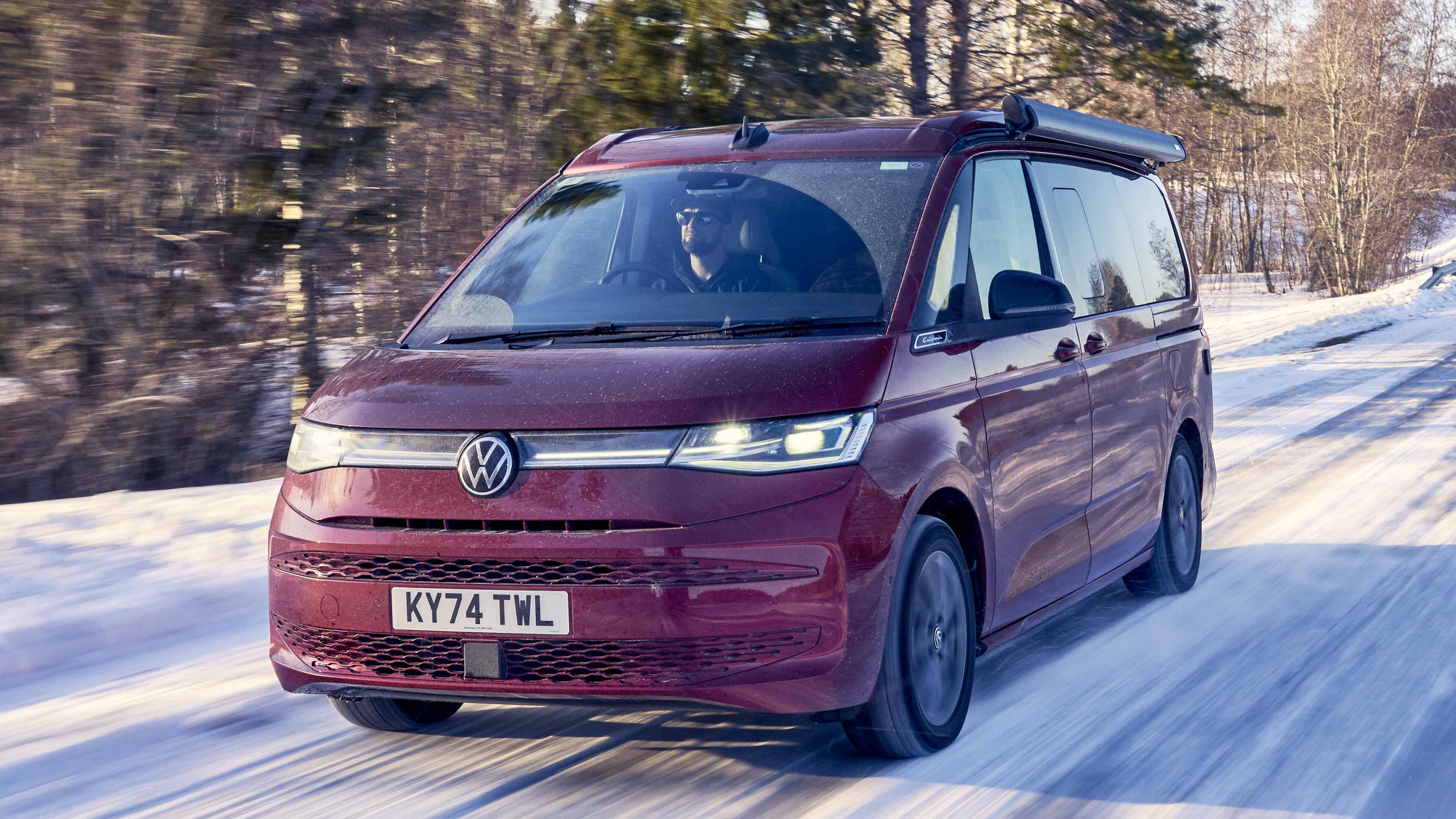
Trending this week
- Car Review
Omoda 9






